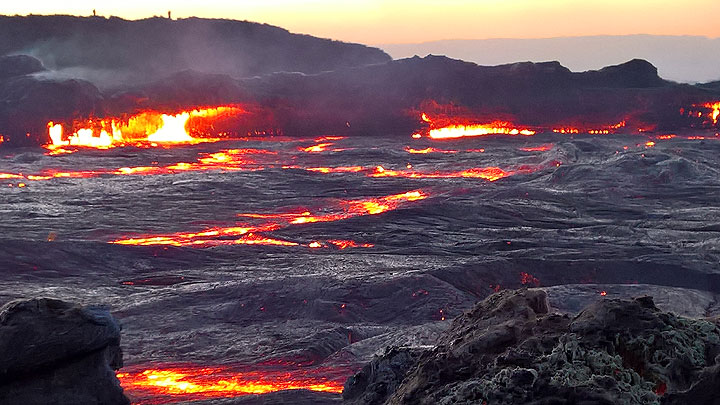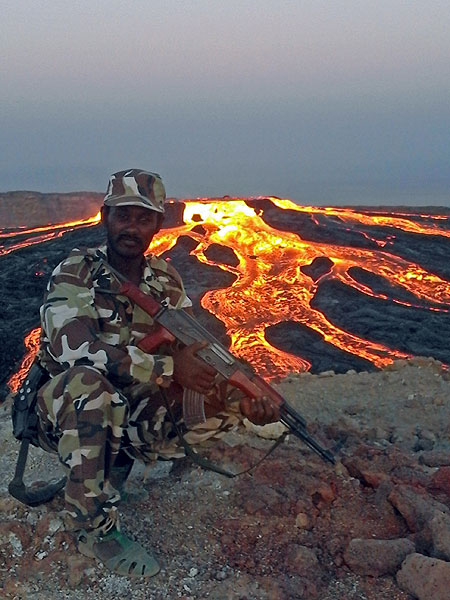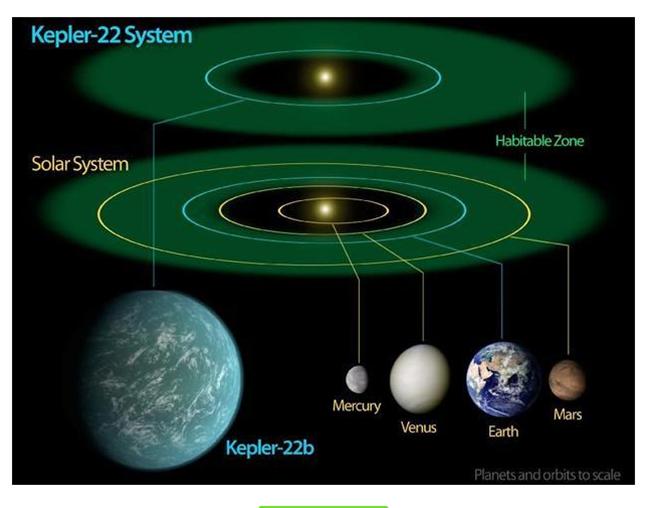 Erta Ale volcano (Ethiopia): massive lava lake overflows, collapses inside caldera: "Erta Ale volcano (Ethiopia): massive lava lake overflows, collapses inside caldera Tuesday Jan 24, 2017 14:24 PM | BY: T The lava lake overflowing on all sides on 17 Jan 2017 (Photo: Enku Mulugeta) Heat signal from Erta Ale showing the extreme peak since 19 Jan (MIROVA) Sentinel satellite image of the volcano's caldera on 19 Jan, showing the overflows in the days before and on 19 Jan itself (image: SENTINEL-ESA/Copernicus, annotations: Culture Volcan) The volcanic activity at the shield volcano in the Danakil desert has been at extraordinary and very elevated levels recently. Participant returning from our recent eruption special tour (14-20 Jan) reported that during their stay 16-20 Jan, the lava lake's surface level has been undergoing rapid and large variations, producing massive lava lake overflows when high and intense spattering when low. The activity generated a thermal signal that rose to 13 GW, a peak of approx. 100 times the normal average on 19 Dec and has stayed very high since! Following / accompanying this large surge in lava flow activity, several large collapses have been reported from both the also active northern crater and the lava lake itself on and since 20 Jan. It seems that the volcano is currently in a major phase reshaping itself. This is an eye-witness report from the activity during 17-19 Jan, which our participant Richard just sent in" "... Monday Jan 16 - after finishing a morning climb and breakfast we went into the caldera to watch a lava lake. We approached as close as 4m from the lava lake edge just observing a lava surface waving (30cm in amplitude). Lava waves were hitting the edge of the lake creating small fountains (1-2 m of height). Then we climbed the rest of a big hornito next to the pit. In 30 minutes the first over flow appeared on a western rim. ... In the afternoon other two lava rivers appeared on SW flank (the length ca 500 m). Tuesday Jan 17 - till midday the volcano was almost calm with the waving surface and small fountains. At about 1PM two overflows began on south rim and during the time the lava flows were intensifying. At 2 PM we went into the caldera to observe lava flows in close proximity. At about 3 PM other overflows appeared on NE and N flank and at last cca 70% of the lava lake rim was overflowed. I can hardly say it was overflow - it was a lava flood or an eruption. The volcano was producing about 200-300 m3 of fresh lava per second and it lasted cca 15 hours. The speed of the lava flows on the flank was 50-70km per hour and the lava covered about 1km2 of the surface inside the caldera. One of the lava flows stopped 60m in front of the camp cliff. What to say in the end - I have never seen so much lava during all my life including all documentary movies. It was absolutely amazing! Wednesday Jan 18 In the morning the all surroundings of the south pit (500-700 m in all directions) was covered with glowing lava and it was impossible to approach the caldera edge in SW part due to the glow. In the afternoon there were a sporadic overflows and the activity has changed. The lava lake level was fluctuating very fast (minutes) +- 10m. When in high level the short time overflows appeared, when in low level the activity was similar to Strombolian one - there were the fountains reaching up to 50-60m of the height. Really a good spectacle. Thursday Jan 19 Activity was the same as a previous day - big fountains with sporadic lava flows reaching 500m and the fluctuating lake level +-15m . We were so tired of the lava observation we started looking at outer flanks of Erta Ale. " (Our group left early on 20 Jan after 4 days camp on the rim). More news: fresh satellite imagery and collapses in the caldera A Sentinel 2 image from 19 Jan (attached) retrieved and commented by Culture Volcan shows the very large lava overflows that Richard described above, and occurred mainly during mainly on 17 Jan, half overlaid by a fresh flow from 19 Jan. Based on the satellite image, the new lava flows combined reached a length of a bit more than 1 km and extended more than 230 m, covering a surface of approx. 200 000 square meters. Photographer Oliver Grunewald was on the spot and reported (via Culture Volcan) that on the evening 20 Jan, explosions of very large gas bubbles occurred from the lava lake, with projections of lava spatter reaching to up to 30 m. More importantly, he observed that the caldera started to undergo large collapse phases, a sign that the intense output of magma has reached critical values of drained volumes from the magma reservoirs below, resulting in surface collapses (and making any stay inside the caldera extra dangerous now). One collapse affected the northern crater, where a new oval-shaped pit crater of 150 x 30 m dimension and 20 m depth formed during 24 hours. Another collapse affected the lava lake itself in the southern crater, doubling its size. The activity was accompanied by ash emissions that reached 7-800 m height, and lava flows have been covering much of the southern part of the caldera where the active pit craters are located. What will happen next at the volcano remains unknown, but current visitors of the volcano including those on our next tours to the Danakil are certainly in for once-in-a-lifetime show. If there is sufficient interest, we can also offer a new Erta Ale Special. All news about: Erta Ale volcano Information about: Erta Ale volcano --- Links / Sources: Très gros débordement du lac de lave à l'Erta Ale! (Culture Volcan) "
Erta Ale volcano (Ethiopia): massive lava lake overflows, collapses inside caldera: "Erta Ale volcano (Ethiopia): massive lava lake overflows, collapses inside caldera Tuesday Jan 24, 2017 14:24 PM | BY: T The lava lake overflowing on all sides on 17 Jan 2017 (Photo: Enku Mulugeta) Heat signal from Erta Ale showing the extreme peak since 19 Jan (MIROVA) Sentinel satellite image of the volcano's caldera on 19 Jan, showing the overflows in the days before and on 19 Jan itself (image: SENTINEL-ESA/Copernicus, annotations: Culture Volcan) The volcanic activity at the shield volcano in the Danakil desert has been at extraordinary and very elevated levels recently. Participant returning from our recent eruption special tour (14-20 Jan) reported that during their stay 16-20 Jan, the lava lake's surface level has been undergoing rapid and large variations, producing massive lava lake overflows when high and intense spattering when low. The activity generated a thermal signal that rose to 13 GW, a peak of approx. 100 times the normal average on 19 Dec and has stayed very high since! Following / accompanying this large surge in lava flow activity, several large collapses have been reported from both the also active northern crater and the lava lake itself on and since 20 Jan. It seems that the volcano is currently in a major phase reshaping itself. This is an eye-witness report from the activity during 17-19 Jan, which our participant Richard just sent in" "... Monday Jan 16 - after finishing a morning climb and breakfast we went into the caldera to watch a lava lake. We approached as close as 4m from the lava lake edge just observing a lava surface waving (30cm in amplitude). Lava waves were hitting the edge of the lake creating small fountains (1-2 m of height). Then we climbed the rest of a big hornito next to the pit. In 30 minutes the first over flow appeared on a western rim. ... In the afternoon other two lava rivers appeared on SW flank (the length ca 500 m). Tuesday Jan 17 - till midday the volcano was almost calm with the waving surface and small fountains. At about 1PM two overflows began on south rim and during the time the lava flows were intensifying. At 2 PM we went into the caldera to observe lava flows in close proximity. At about 3 PM other overflows appeared on NE and N flank and at last cca 70% of the lava lake rim was overflowed. I can hardly say it was overflow - it was a lava flood or an eruption. The volcano was producing about 200-300 m3 of fresh lava per second and it lasted cca 15 hours. The speed of the lava flows on the flank was 50-70km per hour and the lava covered about 1km2 of the surface inside the caldera. One of the lava flows stopped 60m in front of the camp cliff. What to say in the end - I have never seen so much lava during all my life including all documentary movies. It was absolutely amazing! Wednesday Jan 18 In the morning the all surroundings of the south pit (500-700 m in all directions) was covered with glowing lava and it was impossible to approach the caldera edge in SW part due to the glow. In the afternoon there were a sporadic overflows and the activity has changed. The lava lake level was fluctuating very fast (minutes) +- 10m. When in high level the short time overflows appeared, when in low level the activity was similar to Strombolian one - there were the fountains reaching up to 50-60m of the height. Really a good spectacle. Thursday Jan 19 Activity was the same as a previous day - big fountains with sporadic lava flows reaching 500m and the fluctuating lake level +-15m . We were so tired of the lava observation we started looking at outer flanks of Erta Ale. " (Our group left early on 20 Jan after 4 days camp on the rim). More news: fresh satellite imagery and collapses in the caldera A Sentinel 2 image from 19 Jan (attached) retrieved and commented by Culture Volcan shows the very large lava overflows that Richard described above, and occurred mainly during mainly on 17 Jan, half overlaid by a fresh flow from 19 Jan. Based on the satellite image, the new lava flows combined reached a length of a bit more than 1 km and extended more than 230 m, covering a surface of approx. 200 000 square meters. Photographer Oliver Grunewald was on the spot and reported (via Culture Volcan) that on the evening 20 Jan, explosions of very large gas bubbles occurred from the lava lake, with projections of lava spatter reaching to up to 30 m. More importantly, he observed that the caldera started to undergo large collapse phases, a sign that the intense output of magma has reached critical values of drained volumes from the magma reservoirs below, resulting in surface collapses (and making any stay inside the caldera extra dangerous now). One collapse affected the northern crater, where a new oval-shaped pit crater of 150 x 30 m dimension and 20 m depth formed during 24 hours. Another collapse affected the lava lake itself in the southern crater, doubling its size. The activity was accompanied by ash emissions that reached 7-800 m height, and lava flows have been covering much of the southern part of the caldera where the active pit craters are located. What will happen next at the volcano remains unknown, but current visitors of the volcano including those on our next tours to the Danakil are certainly in for once-in-a-lifetime show. If there is sufficient interest, we can also offer a new Erta Ale Special. All news about: Erta Ale volcano Information about: Erta Ale volcano --- Links / Sources: Très gros débordement du lac de lave à l'Erta Ale! (Culture Volcan) "
